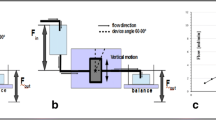Abstract
The currently available hydrocephalus valves are still far from perfect. Whereas the design principles of differential pressure valves and adjustable devices involve the danger of overdrainage, hydrostatic valves have a tendency to clog. The new dual-switch valve (DSV) avoids overdrainage-related problems such as subdural hygromas/hematomas or slit-like ventricles with the high risk of proximal catheter obstruction by means of two parallel chambers in a titanium casing: one for the the horizontal and the other for the vertical position. The control chamber for the horizontal position is closed by a gravity-activated tantalum ball as soon as the patient moves into an upright position. Now the drainage of CSF is directed into the appropriate controller for the erect position. Thus, the hydrostatic differential pressure between ventricles and peritoneal cavity is counterbalanced and the intraventricular pressure (IVP) remains within physiological values independently of the CSF flow and the position of the patient. To avoid the problem of clogging, the newly designed valve introduces large-area diaphragms to create extensive acting forces. The forces generated in this way are able to overcome sticking forces set up as a result of high protein content or cellular debris. By this mechanism the IVP is maintained in physiological ranges regardless of the CSF composition. The new valve has been investigated with a computer controlled test apparatus especially designed to simulate different positions of the body. The in vitro test results according to ASTM standards document a superior performance in comparison with other valves. When the new device was interposed in external drainage systems precision of its function was confirmed even in the presence of elevated protein content and high CSF flow. Simulation of the upright position of the patient allowed documentation of the valve's reliability in maintaining the IVP within physiological ranges. A clinical trial with implantation of the new dual-switch valve was started at the beginning of 1995; so far follow up has been short. Clinical and computer tomographic monitoring has provided evidence of the valve's capacity to avoid the problems of overdrainage and early clogging.
Similar content being viewed by others
References
Albeck MJ, Boergesen SE, Gjeris F, Schmidt JF, Soerensen PS (1991) Intracranial pressure and cerebrospinal fluid outflow conductance in healthy subjects. J Neurosurg 74:597–600
Aschoff A, Benesch C, Kremer P, Haken MS von, Klank A, Osterloh M, Fruh K (1993) The solved and unsolved problems of hydrocephalus valves: a critical comment. Adv Neurosurg 21:103–114
Aschoff A, Kremer P, Benesch C, Fruh K, Klank A, Kunze S (1995) Over-drainage and shunt technology. A critical comparison of programmable, hydrostatic and variable-resistance valves and flow-reducing devices. Child's Nerv Syst 11: 193–202
Epstein F, Hochwald G, Ransohoff J (1973) A volume control system for the treatment of hydrocephalus: laboratory and clinical experience. J Neurosurg 38: 282–287
Gruber R (1979) Zur Therapie des kindlichen Hydrozephalus. Ein kritischer Vergleich zwischen ventrikuloperitonealer und ventrikulo-atrialer Ableitung und deren Komplikationen. Z Kinderchir 28: 212–225
Gruber R (1983) Should “normalisation” of the ventricles be the goal of hydrocephalus therapy. Z Kinderchir 38 [Suppl II]: 80–83
Hirayama A (1982) Slit ventricle — a reluctant goal of ventriculoperitoneal shunt. Monogr Neural Sci 8: 108–111
Illi OE, Minikus H, Kaiser G (1986) Suggestions for the construction of a flow-reducing device in the treatment of hydrocephalic children, based on clinical and experimental results. Z Kinderchir 41: 137–140
Kadowaki C, Hara M, Numoto M, Takeuchi K, Saito I (1995) CSF shunt physics: factors influencing in shunt CSF flow. Child's Nerv Syst 11: 203–206
Kaiser G (1983) Der arretierte Shuntunabhängig gewordene Hydrozephalus. Z Kinderchir 38: 73–80
Magnaes B (1976) Body position and cerebrospinal fluid pressure. 1. Clinical studies on the effect of rapid postdural changes. J Neurosurg 44: 687–697
McCullough DC (1986) Symptomatic progressive ventriculomegaly in hydrocephalus with patent shunt and antisiphon devices. Neurosurgery 19: 617–621
Miethke C, Affeld K (1994) A new valve for the treatment of hydrocephalus. Biomed Tech (Berlin) 39: 181–187
Olsen L, Frykberg T (1983) Complications in the treatment of hydrocephalus in children. Acta Paediatr Scand 72: 385–390
Pudenz RH, Foltz EL (1991) Hydrocephalus: overdrainage by ventricular shunts. A review and recommendations. Surg Neurol 35: 200–212
Sainte-Rose C (1993) Shunt obstruction. A preventable complication? Pediatr Neurosurg 19: 156–164
Sainte-Rose C, Hooven MD, Hirsch JF (1987) A new approach in the treatment of hydrocephalus. J Neurosurg 66: 213–226
Schöner WF, Reparon C, Verheggen R, Markakis E (1991) Evaluation of shunt failures by complicance analysis and inspection of shunt valves and shunt materials, using microscopic or scanning electron microscopic techniques. In: Matsumoto S, Tamaki N (eds) Hydrocephalus. Pathogenesis and treatment. Springer, Tokyo Berlin Heidelberg, pp 452–472
Sprung C, Schulz B (1982) Correlation of postoperative clinical course and ventricular size determined by computed tomography in normal pressure hydrocephalus. Adv Neurosurg 10: 156–163
Trost HA (1995) Is there a reasonable differential indication for different hydrocephalus shunt systems? Child's Nerv Syst 11: 189–192
Author information
Authors and Affiliations
Rights and permissions
About this article
Cite this article
Sprung, C., Miethke, C., Trost, H.A. et al. The dual-switch valve. Child's Nerv Syst 12, 573–581 (1996). https://doi.org/10.1007/BF00261650
Received:
Issue Date:
DOI: https://doi.org/10.1007/BF00261650




